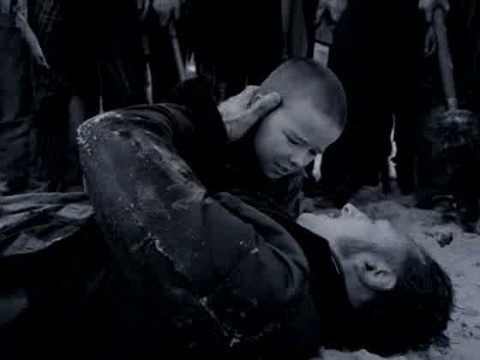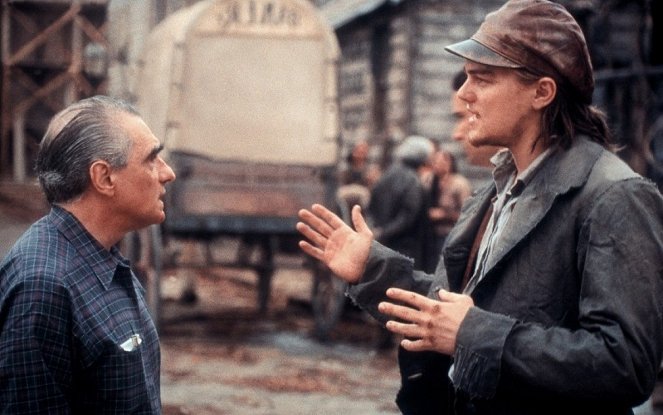Réalisation:
Martin ScorsesePhotographie:
Michael BallhausMusique:
Howard ShoreActeurs·trices:
Leonardo DiCaprio, Daniel Day-Lewis, Cameron Diaz, Jim Broadbent, John C. Reilly, Henry Thomas, Liam Neeson, Brendan Gleeson, Gary Lewis (plus)Résumés(1)
1846, le quartier de Five Points, un faubourg pauvre de New York, est le théâtre d'une guerre des gangs entre émigrants irlandais d'un côté, les "Dead Rabbits" menés par Père Vallon, et les "Native Americans" de l'autre, dirigés par le sanguinaire Bill le Boucher. Ce dernier met rapidement en déroute les "Dead Rabbits" en assassinant leur chef, et prend par la même occasion le contrôle exclusif des rues de la "grosse pomme". Afin de renforcer ses pouvoirs, Bill s'allie avec Boss Tweed, un politicien influent.
Seize ans plus tard, le gang des "Native Americans" règne toujours en maître dans New York. Devenu adulte, Amsterdam Vallon souhaite venger la mort de son père en éliminant Bill. Mais sa rencontre avec Jenny Everdeane, une énigmatique pickpocket dont l'indépendance et la beauté le fascinent, va compliquer les choses...
(SND)
Vidéo (2)
Critiques (11)
The question is what you expect from a filmmaker of Scorsese's calibre: a disposable product or something that will last for ages and that you will love to come back to. I expected the latter, but got the former. The product comes in an attractive package, the production design is meticulously detailed, there are dozens of extras in front of the camera in most shots, and the 100 million budget is palpable. Scorsese artfully inserts shots of period illustrations into the plot, which positively highlight the atmosphere of 19th century New York. The actors, Caprio and Diaz are excellent, but above them all looms the demonic Day Lewis with his artificial eye, you wouldn’t want to mess with him. The story: that’s were they dropped the ball. Gangs of New York is a portrait of an era that doesn’t go deep. The first two acts run like clockwork, but after a plot twist in the last act, the whole narrative goes haywire leading to a completely chaotic ending. The question is who is the culprit, the frequent reshoots or the bad script. I often like to return to Scorsese's films, such as The Last Temptation of Christ or Taxi Driver, as true art with profound content. Unfortunately, there’s no chance of that in this case. Overall, I'd say it's about a three-and-a-half-star film, but the actors give it their all and my respect for the Master is still high.
()
That organized crime played a significant role in the building of American society, not only during Prohibition, is widely known, and the intertwining of American political elites at the local level with the underworld could be the basis for epic TV series that would grab the attention of crowds while still staying true to reality. Scorsese could have undoubtedly directed a magnificent story without using exaggerated elements like in the case of Gangs of New York. Even the opening scene of the battle between two clans looks like something out of a dark medieval fantasy, full of characters who seem to have just stepped out of a sadomasochistic roleplay session. It's all shot for effect, with brutal violence and exaggeration that would be more fitting for a comic book. What works perfectly is the scene that truly breathes a romanticized, yet still somewhat accurate, history of America's most famous metropolis. The cast, led by Leonardo DiCaprio and Daniel Day-Lewis, is also solid. However, from a director of Martin Scorsese's caliber, I expected something more than a costume drama with a B-movie theme based on these non-existent underworld rituals and their glorification. The reality was much more down-to-earth. Overall impression: 60%.
()
The script is a questionable mess that probably wants to be something in the style of The Godfather or Once Upon a Time in America, but in the end it is just a patchwork of scenes. But those scenes are so impressively delivered and acted that it doesn't really matter that much.
()
Fundamental themes of life in the unusual setting of the 1860s. Daniel Day-Lewis steals the show in every scene, but overall this is a showcase of exceptional acting performances, and the actors really have some material to work with. Even Marty flashes past the camera in the role of the head of a robbed family. Amazing sets.
()
“The blood stays on the blade.” With Gangs of New York, Scorsese dug deep into the past while picking up the threads of Goodfellas and Casino, compared to which Gangs has a somewhat more conventionally constructed story, though it unconventionally depicts two rises and only one fall. The streets on which the plot is set are mean this time and we don’t have to refer to swine in only a figurative sense in connection with them. Dickens’s protagonists would have been right at home in them. After all, one such protagonist stands at the centre of the narrative (and speaks to us through the essential voice-over). Unlike Oliver Twist, however, he doesn’t learn to steal from his victims, but to beat, stab and slash them. Marked by his strict Catholic upbringing (what else?), Amsterdam Vallon serves as our guide. We learn through him what happened when a certain social class in New York lived the final years of its age of innocence. The young protagonist serves as a harbinger of the oncoming end of the era of men who wanted to always have the last word even though they knew only how to fight and diplomacy was a foreign concept to them. After he finds his footing and joins a gang, he can start working toward his primary goal: to avenge his father. In order to achieve that, he must kill another father figure (with whom he shares a woman in an Oedipal way), a psychopathic butcher who dresses like Willy Wonka (though he is otherwise characterised by a diabolical shade of red) and doesn’t make much of a distinction between the flesh of humans and animals. Only an unsuccessful assassination attempt and the subsequent punishment cure the protagonist of his selfishness and force him to play a more significant role in events. After Amsterdam’s revival, the film starts anew, which justifies the expansive runtime. Just like the other characters, however, Amsterdam is repeatedly confronted with the cold, hard fact that his problems and the trivial war that he is waging are losing significance (which egotistical men assign to it) in the shadow of ongoing major events and the Civil War. At the same time, what’s happening in Five Points is a local reflection of national events: on both levels, two Americas are at war with each other. The “pure” America of conservative native-born residents and the new multicultural America of immigrants. The victory of the latter heralded how not only New York would look a few decades later, but the whole United States (the character of Bill the Butcher, who takes a little from the divider of the people Abraham Lincoln and a little from George W. Bush, another powerful figure who brings about order through fear, invites a search for other political parallels). The film not only ends with the blending of the past and the present, but also begins, though the present is represented only by non-diegetic music in the opening brawl. It’s obviously not necessary to spend a lot of time writing about Scorsese’s skill as a director. He knows exactly when to use a lap dissolve, when to use views from above and below, and when to throw in a jump cut to keep the film moving while bearing his unmistakable creative signature (even here, the setting is presented in a single long shot in the mould of direct cinema documentaries). Proof of all of this can be found in the boxing match with flawlessly timed cuts between the medium shots, when the fighters are in motion, and the close-ups when they deliver blows. Scorsese has again demonstrated a tremendous eye for detail and an ability to thoroughly get a feel for any place and any period (whether temporally or culturally), no matter how remote. Instead of television footage and period songs (though these are also present in the film), he uses leaflets and newspaper articles from the period. The slang used by the street rabble is authentic and the impression of a different time is disrupted mainly by the famous actors. By that, I of course don’t mean to insinuate that I wouldn’t enjoy watching, for example, Daniel Day-Lewis tapping his own glass eye with a knife. Gangs of New York is a great film that doesn’t shy away from showing that the hands that built America were thoroughly soaked in blood. Given the post-9/11 atmosphere at the time of the film’s release, the ending is gentler than Scorsese would have otherwise allowed, but I think a little gentleness is justifiable after two and half hours of epic slaughters. 85%
()
(moins)
(plus)



Annonces